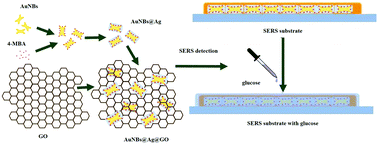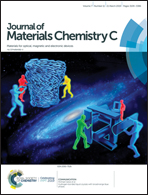SERS detection of glucose using graphene-oxide-wrapped gold nanobones with silver coating†
Abstract
In this work, we prepared graphene oxide (GO)-decorated silver-coated gold nanobones (AuNBs@Ag@GO) for obtaining optimal surface-enhanced Raman scattering (SERS) activity. 4-Mercaptobenzoic acid (4-MBA) was adsorbed on the interface between gold and silver to provide more space for GO decoration on the outer surface of silver. Silver was deposited on the middle and end surfaces of the gold nanobones (AuNBs) with negative curvature, which resulted in stubby bimetallic nanocuboids inducing transverse surface plasmon resonance (SPR); the intermediate SPR merged into a new plasmon resonance. The SERS activity of silver-coated gold nanobones (AuNBs@Ag) changed non-monotonically with an increase in the silver coating, which reached up to 8 times larger than that of bare AuNBs. This is better performance than that of silver-coated gold nanorods (AuNRs@Ag). GO hybridized with AuNBs@Ag by electrostatic adherence could further improve the SERS activity of AuNBs@Ag, and the concentration of GO was adjusted for the best SERS performance, which was 4 times higher than that of naked AuNBs@Ag. AuNBs@Ag@GO can be used as a SERS substrate to detect glucose in urine. The mechanism is that the higher concentration of liquid glucose induced a large density of coverage, forming a glucose partition layer on the AuNBs@Ag@GO substrate: with an increase in the glucose concentration, the thickness of the glucose partition layer increased. This reduced the intensity of incident light and resulted in a decrease in the Raman signal of 4-MBA. Moreover, the strong SERS activity of the AuNBs@Ag@GO substrate can provide a wider space to achieve a lower limit of detection (LOD) value for glucose. The intensity of the characteristic Raman peak at 1585 cm−1 linearly decreased with an increase in the glucose concentration in the range of 10–107 nmol L−1 with a low LOD value (S/N = 3) of 2.61 nmol L−1. At the same time, it is confirmed that the SERS substrate can be selective and reliable and shows promising potential and broad applications in glucose detection.



 Please wait while we load your content...
Please wait while we load your content...